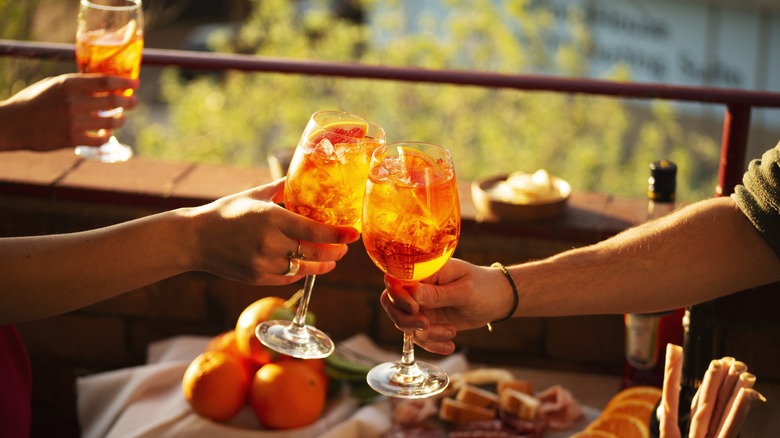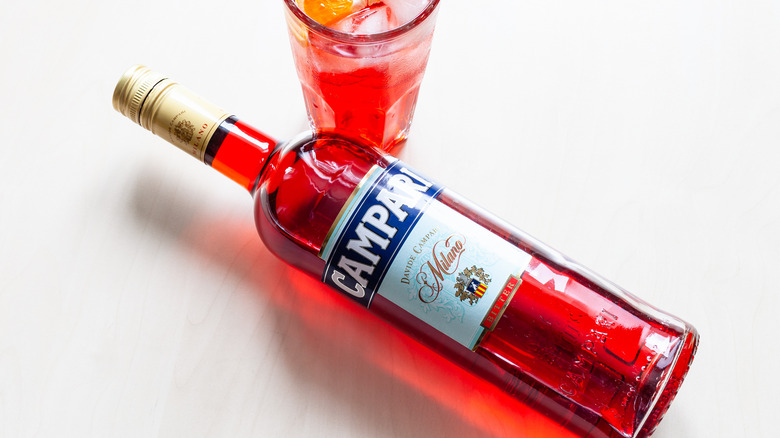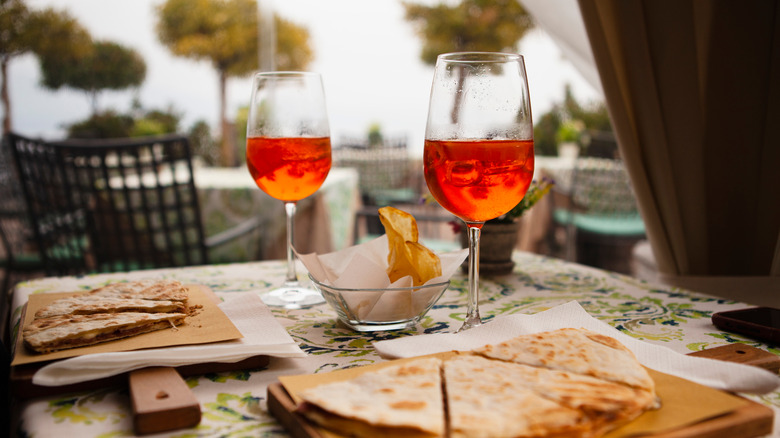Use Aperol For A Refreshing Boost, Use Campari For Complexity
It's an apéritif that has been lauded in rock songs for decades — the elusive Aperol. Often indulged in as an aperitivo in a classic Aperol Spritz (also known as a pre-meal drink), it's almost equally regarded alongside its sister apéritif, Campari. Both of these bitters serve primarily as beloved Italian apéritifs that are bitter on the tongue and colorful in a glass.
For those not as familiar with these two apéritifs, their differences might elude you. However, even the most devoted lovers of any of the two bitters could be living in the same state of confusion. Both Aperol and Campari are bitter and vibrant after all, so are they interchangeable? Usually, the answer is no, and we're here to fill you in on why. Some argue you should use Aperol for a refreshing boost and Campari for complexity. Before we dive into those arguments, let's talk about the contents of each bitter so you can decide if you're team red or orange.
Campari v. Aperol: what's the difference?
The Campari and Aperol bitters are staples all around the world, but especially in European countries like Italy. These are the regions where both of these indulgences originated, and it's also where aperitifs have become something of a tradition after meals. Beyond origins, what exactly is in both of these apéritifs?
While the actual recipes are kept secret, we know that the ruby red Campari originates from Milan. The drink came about in the mid-1800s and is crafted with fragrant herbs and orange peel, which gives it a strong, almost perfumey taste. The recipe has not been altered since its founding. As for Aperol, this bitter was invented in 1912 after two brothers inherited their father's liquor company. The two worked together and experimented for years, trying to craft a low-alcohol apéritif, and finally made a breakthrough with Aperol. The original recipe is still used today and makes for a taste full of bitter orange and rhubarb. With a vibrant hue and herb-forward taste, Aperol mimics much of the Campari taste.
These apéritifs differ widely in their alcohol content, with Aperol at 11% and Campari at twice that at around 20%. However, there is more to their differences than that.
Why you should have one of each in your bar
While the two apéritifs differ slightly in contents, the taste of each is also unique, which is why they're used in different drinks. As beverage director of Grand Tour Hospitality Simon Sebbah shared with Food & Wine, Campari is a great choice for when you are seeking a deep, rich herbal flavor for your drink. This makes it a great paring with floral-forward gins and bourbons. No matter your liquor of choice, remember that Campari has a very distinctive bitter taste and can overpower other ingredients, if you're not careful. This means that unless you're making a spritz, it's best to pair Camapri with other equally strong flavors and bitters, like the ingredients in a Negroni.
As for Aperol, it's the perfect addition to sweeter, lighter drinks — this is why you might see Aperol frequently during the summer months (think of it as a more mild version of Campari). The bitter addition can provide a great contrast to sweeter drinks without the heaviness of Campari. In conclusion, if you're feeling adventurous, reach for a bottle of Campari. If you want to add a refreshing splash of bitterness to a cocktail or something with a little less alcohol, stick with Aperol.


